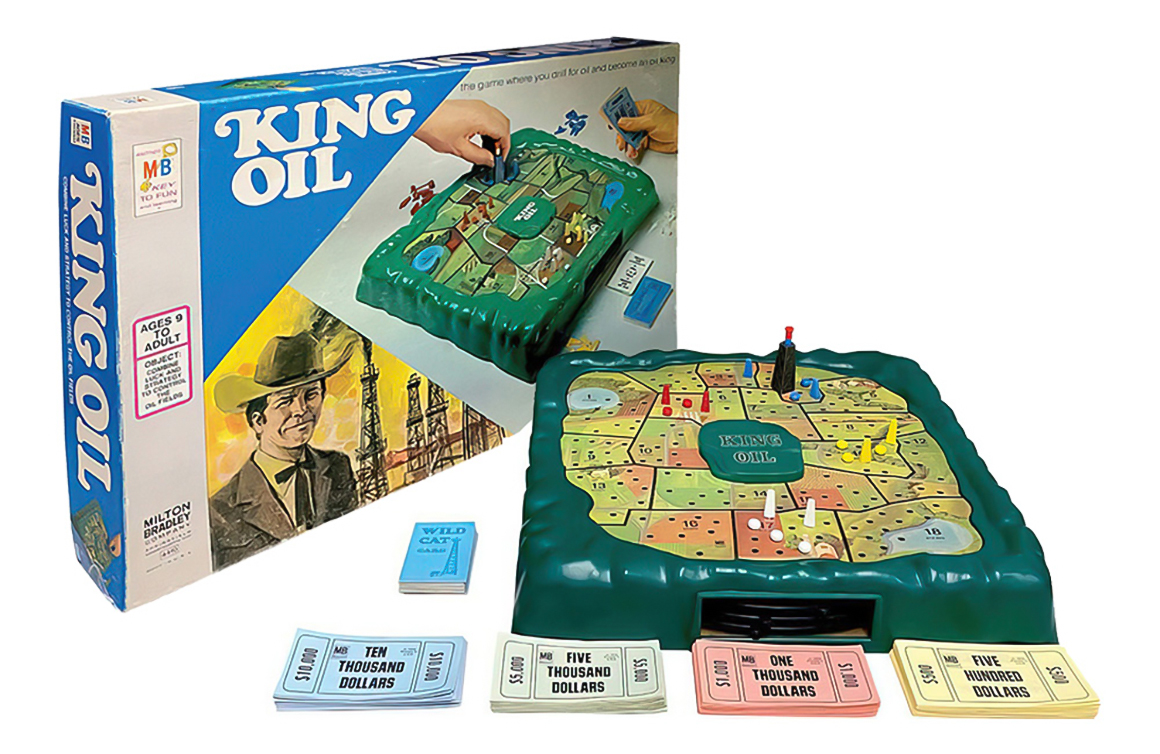“There are fortunes to be made and lost in oil.”
A combination of luck, strategy, and ruthlessness was needed to come out on top in the King Oil board game. Released in 1974 by Milton Bradley, the game challenged players to buy land, drill for oil, expand production, and make the acquisitions necessary to financially decimate opponents.
GAMEPLAY
The molded plastic playing surface depicted plots of bucolic farmland numbered one through 18, each displaying a purchase price. A series of small holes in the playing surface denoted pre-determined drilling spots.
No game was the same thanks to three black discs punched with holes of varying diameters affixed in a stack to the underside of the playing surface. The position of the discs was adjusted at the beginning of each game. As a player placed the rig onto a hole, the stem of the rig would encounter the discs and the pin on the rig would indicate whether an oil well was discovered, as well as its depth.
Players chose which plot of land to buy, first using the $80,000 distributed to each player at the beginning of the game. The player who purchased the most expensive piece of land got to start.
Each play began by drawing a wildcat card. Wildcat cards (with the exception of 2 Fire cards in the deck) had three sections. The top section was a financial transaction in the form of a royalty payment from the bank for any producing oil rigs owned by the player, or a cash allowance. The middle section revealed how many wells the player was allowed to drill during that turn. The bottom section allowed the player to purchase, or blocked them from purchasing, additional property. The two Fire cards were penalties that forced players to close a specific number of oil wells.
With the actions on the wildcat card completed, a player could drill for oil on their property. The stem of the rig was inserted into one of the holes in the playing surface. One of four outcomes was possible: 1) the pin didn’t move, meaning the well was dry, 2) a shallow oil well was discovered (denoted by three colours of pin showing), 3) a medium oil well was discovered (two coloured pins), or 4) a deep well was discovered (one pin). Caps were placed on the dry wells and derricks were placed on the successful drilling sites. Fees were due to the bank in each drilling scenario.
Players took turns actioning Wildcat cards and drilling for oil. As players accumulated oil discoveries, they were allowed to install pipelines, receive royalties from their opponents, and build their assets.
A player’s supply of cash diminished as they paid out drilling fees to the bank and royalty fees to opponents. A string of bad luck and cash mismanagement meant they could be forced into bankruptcy. In the case of bankruptcy, the player’s assets were auctioned by the bank to the remaining players.
The game was won when all but 1 player declared bankruptcy and was crowned King Oil.
IN THE BOX
A complete game included a plastic molded game board with 3 moveable black discs concealed underneath, an oil rig, boxes of parts for each player that included derricks, well caps, pipelines, and sheds (players chose from white, blue, yellow, or red sets of parts), wildcat cards, and paper play money in $500, $1000, $5000, and $10,000 denominations. An instruction booklet was included in the box.
COLLECTOR CONSIDERATIONS
King Oil games and replacement parts are often found in online marketplaces such as eBay, in vintage toy shops, and at garage sales. Past environment, handling, and storage are all factors that affect the condition of a game. Nicolas Ricketts of The Strong National Museum of Play shares his professional advice on game preservation for Toy Tales.
Note: If you buy something using the eBay link in this story, we may earn a small commission. Thank you for supporting independent toy journalism!

